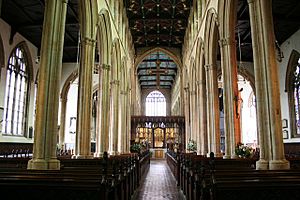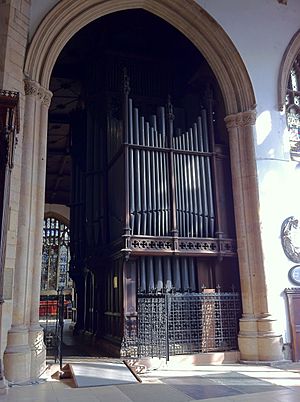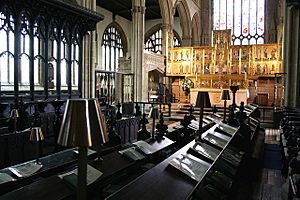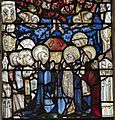St Mary Magdalene Church, Newark-on-Trent facts for kids
Quick facts for kids St Mary Magdalene ChurchNewark-on-Trent |
|
|---|---|
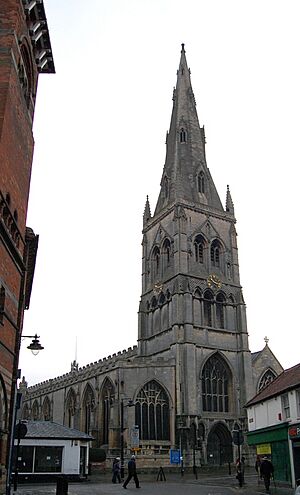
St Mary Magdalene Church, Newark on Trent
|
|
| 53°04′36″N 00°48′30″W / 53.07667°N 0.80833°W | |
| OS grid reference | SK 79945 53928 |
| Location | Newark-on-Trent, Nottinghamshire |
| Country | England |
| Denomination | Church of England |
| Previous denomination | Roman Catholicism |
| Churchmanship | Broad church |
| Website | stmnewark.org |
| History | |
| Dedication | St Mary Magdalene |
| Architecture | |
| Heritage designation | Grade I listed |
| Specifications | |
| Length | 215 feet (66 m) |
| Width | 116 feet (35 m) |
| Nave width | 73 feet (22 m) |
| Spire height | 232 feet (71 m) |
| Bells | 10 |
| Administration | |
| Parish | St Mary Magdalene with St Leonard |
| Deanery | Newark and Southwell |
| Archdeaconry | Newark |
| Diocese | Southwell and Nottingham |
| Province | York |
St Mary Magdalene Church in Newark-on-Trent, Nottinghamshire, England, is a very old and important church. It is an Anglican church, meaning it belongs to the Church of England. The church is named after Mary Magdalene.
This church is the tallest building in Newark. It is also one of the highest church buildings in the whole of the UK and the tallest in Nottinghamshire! People have worshipped on this spot for about 1,000 years.
The church you see today is built in the Gothic style. Some parts of it are from the 12th century. It is a Grade I listed building, which means it's a very important historical and architectural site. St Mary Magdalene's is one of the biggest parish churches in England and is known for being very beautiful.
It is a busy church today, holding many services each week. It also has special programmes for young people and children. The church has a set of bells, a wonderful organ, and a choir that started way back in 1532.
The author Simon Jenkins gave the church four stars in his 2009 book England's Thousand Best Churches. He described it as "exhilarating" and praised its "wonder of proportion."
Contents
History of the Church
The church building you see now is actually the third one built on this same spot.
Around 1180, the church was largely rebuilt. A crypt, which is an underground room, from that time still exists today. The main supports inside the church and the west tower were built around 1220. The tall spire was added about 100 years later.
Most of the church, including the main hall (nave), its side aisles, and the chancel (the area around the altar), were built in the 15th century. The transepts (the parts that stick out like arms of a cross) and chapels were added in the early 16th century.
In the mid-1800s, a big restoration project was led by Sir George Gilbert Scott. More work was done in the 20th century by Sir Ninian Comper and others to keep the church in good condition.
Church Design and Features
St Mary Magdalene Church is a large Gothic church. It has a main hall (nave) with side aisles and a chancel. There are also transepts and a single tower with a spire at the west end. On the south side, there's a two-story porch with a library above it. The outside of the church has decorative walls with battlements, like a castle. The church is made of smooth, cut stone.
The Tall Tower
The west tower stands at the end of the main hall. It was built around 1220 in the Early English Gothic style. It has simple, tall, narrow windows. The tower itself is 115 feet (35 metres) high. On top of it is a tall, eight-sided spire that is about 117 feet (36 metres) high. This makes the total height of the tower and spire about 232 feet (71 metres) to the base of the weather vane.
You can see a hole in the spire! People say it was made by a cannonball during the English Civil War long ago.
The tower holds ten bells made by John Taylor & Co in 1842. The heaviest bell weighs over 3,500 pounds (about 1,590 kg). For many years, the church clock was the only one telling time in the town. A new clock was given to the church in 1898. It has three 7-foot wide dials and one 9-foot wide dial. It plays the famous Westminster Quarters chime. In 1971, it was changed to run on electricity.
Inside the Church
Some of the central pillars inside the church are from the very first church building, dating back to the 11th or 12th century. The upper parts of the tower and spire were finished around 1350. The main hall (nave) was built between 1384 and 1393, and the chancel was completed in 1489.
The area around the altar is bordered by two small chapels. One of these chapels has a very special painting called the "Dance of Death." There are also some old memorials and a beautiful brass plaque from the 14th century.
The library above the south porch was given to the church in 1698. On the north wall, there is a large oil painting called The Raising of Lazarus by William Hilton. It used to be the main painting behind the altar.
The chapel of St George was decorated around 1920. The chapel of the Holy Spirit was decorated by Sir Ninian Comper in 1930. He also designed the reredos (the screen behind the altar) in 1937.
The church was officially named a Grade I listed building on September 29, 1950. This means it is considered to be of outstanding architectural or historical importance. It is truly one of the largest and finest parish churches in England.
Restoration Work
The roofs of the south aisle, nave, and chancel were repaired between 1850 and 1852. A large restoration project took place between 1853 and 1855, led by Sir George Gilbert Scott. During this time, old plastered ceilings were removed and replaced with oak. Old galleries and pews were taken out, and the stone parts of the church were cleaned and fixed.
The floor was made level and covered with black and red tiles in the nave. The chancel received special patterned tiles. A new screen was put in, and the old choir stalls were repaired. The organ was moved to a new spot. The church reopened for services on April 12, 1855.
In May 1894, the spire was hit by lightning. The weather cock on top was put back on August 22, 1894, with many people watching. More restoration work on the nave roof, south porch, and spire happened in 1913.
The Magnus Bequest
The church gets support from something called the Magnus Bequest. This is a special charitable fund that was set up in the early 1530s by a man named Thomas Magnus. He gave farms and land in Yorkshire, Lincolnshire, and Nottinghamshire to help the church in four main ways:
- To create and support a free grammar school (a type of school).
- To provide for a song school, which would help keep the church's music and worship at a high standard.
- To make sure there was enough money to manage the fund and keep the farms and lands in good shape.
- To provide extra money for the general well-being of the church or the town, if there was any left over after the first three goals were met.
Music at St Mary Magdalene's
The Organ
At the start of the 1800s, a new organ was installed. It was built by George Pike England and had three keyboards. It cost £1,300 and was first played on November 11, 1804.
The organ was first placed in the west gallery, where the choir used to sing. In 1814, it was moved to the screen in front of the chancel. In the 1850s, the organ was rebuilt and moved again to where it is now, in the south choir aisle.
In 1866, the organ was rebuilt and made much bigger by Henry Willis. He almost doubled its size, creating a large, powerful organ with four keyboards. The organ was rebuilt several more times over the years, including in 1910, 1924, 1938, 1964, and 1978.
Today, the organ uses an electrical system that allows the organ console (where the organist sits) to be moved around. This means the organist can be closer to the congregation and the choir. It was the first four-keyboard organ in the country to have this feature. It can even record and replay performances automatically!
The Choir
The church's choir was started by Thomas Magnus in 1532. It was said to be the only choir outside of cathedrals and famous universities like Oxford and Cambridge that existed before the Reformation (a big change in the church in the 1500s). Girls were allowed to join the main choir starting in 2008.
In February 2012, choral services stopped for a while when a former Rector (the church leader) decided to disband the choir. However, the choir was restarted in 2015. It now focuses on training young people, with support from the Magnus Bequest.
Concerts
The church often hosts concerts, including a "Music for Market" series at lunchtime on Saturdays.
Images for kids
-
Dance of Death panels
-
15th-century stained glass, south aisle, depicting The Ascension
See also
- Grade I listed buildings in Nottinghamshire
- Listed buildings in Newark-on-Trent
- Archdeacon of Newark



